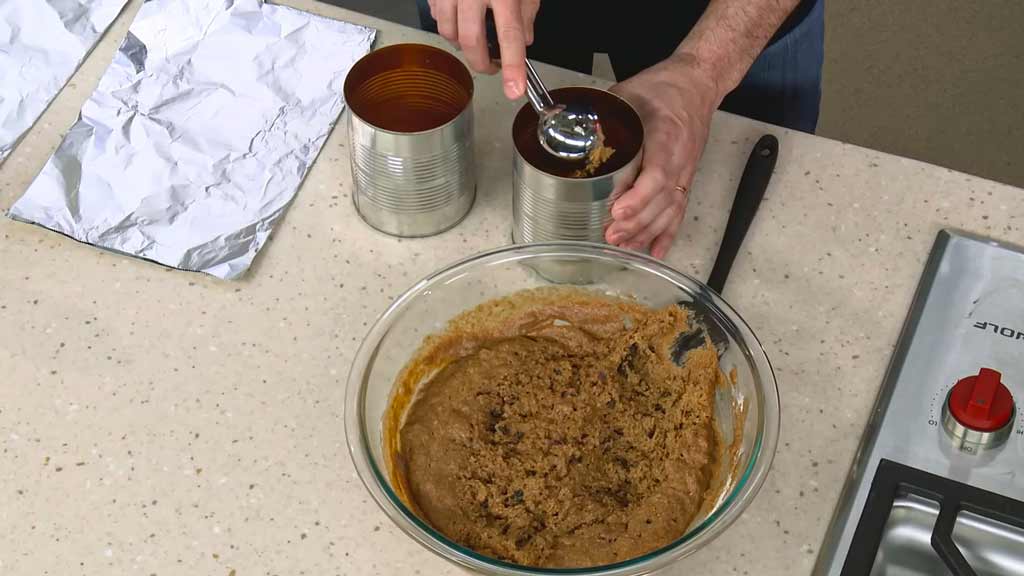Boston Brown Bread, a staple in New England cuisine, traces its roots to the early colonial period, embodying a culinary journey that mirrors the region’s history.
Developed by the resourceful Puritans, this iconic bread reflects a commitment to simplicity and resilience in the face of colonial challenges.
With a unique blend of cornmeal, rye, and molasses, Boston Brown Bread served as a testament to practicality. As time progressed, the bread evolved, adapting to changing tastes and technological advances.
Beyond its ingredients, Boston Brown Bread carries cultural importance, symbolizing community, tradition, and the distinct identity of New England.
Exploring its history unveils a recipe and a narrative woven into the region’s fabric, connecting past and present through the lens of a beloved culinary tradition. So, stay sharp.
The Puritan Connection to Boston Brown Bread History
Boston Brown Bread has historical ties to the Puritans, reflecting the early colonial period in New England.
The Puritans, who arrived in the early 17th century, played a significant role in shaping the cultural and culinary landscape of the region, and their influence can be traced to various aspects of daily life, including food.
Boston Brown Bread is a traditional New England dish that dates back to the colonial era. It is a type of steamed or baked bread made with a combination of flours, including cornmeal, rye, whole wheat, and molasses or other sweeteners.
The Puritans, known for their simple and frugal lifestyle, often used readily available ingredients to prepare their meals, and Boston Brown Bread reflects this practical approach.
Including cornmeal and rye in Boston Brown Bread indicates the grains that were easily cultivated in the New England region.
Adding molasses provided sweetness and served as a preservative, making the bread more durable in the harsh colonial conditions.
The method of steaming or baking the bread in a container, often a tin can, is another historical aspect linked to the Puritans.
The scarcity of ovens in early colonial households led to the development of alternative cooking methods, and steaming, in particular, was a practical technique that could be done over an open fire.
While the specific origins of Boston Brown Bread may not be directly attributed to the Puritans, the recipe and preparation methods align with the principles of early New England settlers.
The 19th Century Controversy with Boston Brown Bread

In the 19th century, Boston Brown Bread emerged as a staple in New England cuisine, carrying with it a rich history deeply rooted in the region’s colonial past.
However, this period also witnessed a culinary controversy surrounding Boston Brown Bread, reflecting societal shifts and debates over its ingredients and preparation methods.
Flour Variations
One significant point of contention was the choice of flour used in Boston Brown Bread.
Traditional recipes incorporate a mix of cornmeal, rye, and whole wheat flour. However, debates arose over the ratios and types of flour, reflecting changing agricultural practices and regional preferences.
Sweeteners and Preservatives
Including molasses as a sweetener and preservative became a source of debate.
While molasses was a common ingredient in early recipes, some factions argued for alternative sweeteners or questioned the necessity of sweetness in bread meant for daily sustenance.
Cooking Techniques

The 19th century marked a shift in cooking technologies and methods. Boston Brown Bread, traditionally steamed in tin cans, faced criticism as ovens became more prevalent.
Some argued for adopting baking over steaming, while others staunchly adhered to the traditional preparation methods.
Socioeconomic Divisions
The controversy around Boston Brown Bread often mirrored broader socioeconomic divisions. The bread’s simplicity and reliance on basic ingredients made it a symbol of frugality and humble living.
However, as societal classes evolved, debates emerged over whether the bread should adapt to more refined tastes or maintain its traditional simplicity.
Culinary Nationalism
The 19th century witnessed a growing sense of culinary nationalism, with regions and communities identifying strongly with their unique dishes.
Boston Brown Bread, being a quintessential New England creation, became a focal point in discussions about regional identity, sparking debates over its authenticity and rightful place in local cuisine.
Health and Nutrition Concerns
Changing perceptions of health and nutrition influenced the controversy around Boston Brown Bread. Some questioned the nutritional value of the bread, particularly in comparison to new dietary trends emerging in the 19th century.
This debate discussed the balance between tradition and modernity in food choices.
The 19th-century controversy surrounding Boston Brown Bread reflects culinary debates and broader societal changes.
Ingredients and Preparation of Boston Brown Bread
Check out the following part to get a brief recipe for Boston Brown Bread;
Ingredients for Boston Brown Bread

- Cornmeal: 1 cup of cornmeal adds a hearty texture and a slightly sweet flavour to the bread.
- Whole Wheat Flour: 1 cup of whole wheat flour contributes a nutty flavour and enhances the nutritional profile of the bread.
- Rye Flour: 1 cup of rye flour adds a distinct taste and complements the other grains in the mixture.
- Baking Soda: 1 teaspoon of baking soda helps the bread rise during cooking.
- Salt: 1/2 teaspoon of salt enhances the overall flavour and balances the sweetness.
- Molasses: 1/2 cup of molasses provides sweetness and is a natural preservative.
- Buttermilk: 1 1/2 cups of buttermilk adds moisture and a tangy flavour to the bread.
- Raisins (optional): A handful of raisins can be added for sweetness and texture.
Preparation
Mix Dry Ingredients
Combine the cornmeal, whole wheat flour, rye flour, baking soda, and salt in a large mixing bowl. Ensure an even distribution of dry ingredients.
Add Molasses
Pour in the molasses, incorporating it thoroughly into the dry mixture. Molasses sweeten the bread and provide a rich, dark colour.
Blend with Buttermilk
Gradually add the buttermilk to the mixture, stirring continuously. This step helps create a thick, batter-like consistency.
Fold in Raisins (Optional)
If using raisins, fold them into the batter. This step adds a burst of sweetness and texture to the bread.
Prepare the Pan
Grease a metal or heatproof glass container (traditionally, a coffee can or pudding mould was used). Ensure it is large enough to accommodate the batter with room for expansion.
Fill the Pan
Pour the batter into the prepared pan, leaving some space at the top for the bread to rise during cooking.
Cover and Steam or Bake
Cover the pan tightly with aluminium foil or a lid. For the traditional steaming method, place the pan in a larger pot with water, elevating it on a trivet. Steam for approximately 2 to 2.5 hours.
Alternatively, bake in a preheated oven at 325°F (163°C) for 1.5 to 2 hours or until a toothpick inserted into the centre comes out clean.
Cool and Slice
Allow the Boston Brown Bread to cool in the pan briefly, then transfer it to a wire rack. Once completely cooled, slice and serve with butter, cream cheese, or other preferred toppings.
Cultural Importance of Boston Brown Bread in New England

Boston Brown Bread, a humble yet culturally significant dish, holds a special place in New England’s culinary heritage.
Originating from the colonial era, this unique bread has transcended time, becoming more than just a traditional recipe; it symbolizes the resilience, resourcefulness, and regional identity of the people of New England.
Colonial Roots and Historical Connection
Boston Brown Bread traces its origins to the early colonial period, reflecting the resourcefulness of the settlers who utilized locally available ingredients.
Its preparation methods and ingredients align with the practical and simple lifestyle of the early New Englanders, creating a tangible link to the region’s history.
Symbol of Frugality and Humility
Boston Brown Bread embodies the values of frugality and humility, reflecting the Puritan ethos of the early settlers.
The use of basic ingredients and simple cooking methods underscores the resourceful nature of the New England community, making it a symbol of resilience and practicality.
Community and Tradition
The preparation and sharing of Boston Brown Bread have deep-rooted ties to communal gatherings and traditions.
Families and communities often come together to prepare and enjoy this dish during special occasions, fostering a sense of togetherness and passing down the recipe through generations.
Distinct Regional Identity
Boston Brown Bread is a culinary emblem of New England, distinguishing the region with its unique flavour and preparation style.
It serves as a marker of regional identity, showcasing the distinctiveness of New England’s culinary traditions amid the broader American food landscape.
Adaptability and Symbol of Resilience
Throughout history, Boston Brown Bread has demonstrated adaptability, evolving to suit the changing times and tastes.
Its continued presence on New England tables symbolizes the region’s resilience, as the dish has weathered societal, economic, and technological changes while remaining a cherished part of the local cuisine.
Culinary Tourism and Promotion
Boston Brown Bread has become a focal point for culinary tourism in New England. Visitors often seek out authentic experiences, including tasting regional specialities.
As a result, the cultural importance of Boston Brown Bread extends beyond local households, contributing to promoting New England’s culinary heritage on a broader scale.
Boston Brown Bread serves as more than just a dish; it is a cultural artefact that connects past and present, community and tradition, and regional identity with the evolving landscape of New England.
How Boston Brown Bread Has Evolved Over the Years?

Boston Brown Bread, with its roots firmly planted in the colonial era, has undergone a fascinating evolution over the years.
As times changed, so did the culinary landscape, leading to shifts in ingredients, preparation methods, and even cultural perceptions of this traditional New England dish.
The evolution of Boston Brown Bread reflects a dynamic interplay between tradition and innovation, adapting to the tastes and lifestyles of different generations.
Colonial Simplicity to Modern Convenience
In its early days, Boston Brown Bread was a product of simplicity, utilizing basic ingredients like cornmeal, rye, and molasses.
Over the years, with the advent of modern conveniences and accessibility to a wider range of ingredients, variations in recipes have emerged.
Some contemporary versions may include additional ingredients or experiment with alternative flours.
Changes in Sweeteners and Flour
Traditional recipes relied on molasses for sweetness and flavour. However, as dietary preferences and health consciousness evolved, some modern adaptations may explore alternative sweeteners like maple syrup or honey.
Additionally, variations in flours, including gluten-free options, cater to diverse dietary needs and preferences.
Technological Advances
The shift from traditional cooking methods, such as steaming in tin cans over an open fire, to modern kitchen appliances like ovens and electric steamers has influenced the evolution of Boston Brown Bread.
This adaptation has made the preparation process more convenient, allowing for wider adoption and experimentation in home kitchens.
Culinary Creativity and Fusion
Contemporary chefs and home cooks often showcase their culinary creativity by infusing new elements into traditional recipes.
Boston Brown Bread has become a canvas for experimentation, with variations incorporating nuts, dried fruits, or even savoury twists, expanding its flavour profile beyond its original simplicity.
Health-Conscious Modifications
As health and nutrition awareness has grown, a trend has been toward incorporating healthier ingredients into traditional recipes.
Whole grain flours, seeds, and other nutritional additives may find their way into modern Boston Brown Bread recipes, aligning with changing dietary preferences.
Commercial Production and Accessibility
The convenience of pre-packaged or commercially produced Boston Brown Bread has become more prevalent in modern times.
While some purists may insist on homemade versions, the availability of store-bought options has contributed to the preservation and widespread recognition of Boston Brown Bread in today’s fast-paced lifestyle.
Cultural Revival and Heritage Awareness
In recent years, interest in traditional and regional cuisines has been resurgent.
This cultural revival has led to a renewed appreciation for dishes like Boston Brown Bread, prompting efforts to preserve and celebrate the historical and cultural significance of this iconic New England bread.
The evolution of Boston Brown Bread is a testament to its adaptability and enduring appeal.
FAQs
How did the Puritans cook Boston Brown Bread without ovens?
The Puritans, lacking ovens, steamed Boston Brown Bread in tin cans over an open fire.
This method showcased their ingenuity, utilizing available resources to create a staple food that could withstand the harsh conditions of colonial New England.
Has the recipe for Boston Brown Bread changed over time?
Yes, the recipe has evolved. While the core ingredients remain, modern variations may include alternative flours, sweeteners, or additional ingredients.
Changes in technology, taste preferences, and dietary awareness have influenced the evolution of Boston Brown Bread over the years.
What cultural importance does Boston Brown Bread hold in New England today?
Boston Brown Bread is a cultural symbol of New England’s culinary heritage.
It embodies the region’s history, resilience, and communal traditions, making it a cherished dish that connects past and present, reflecting the identity of the people of New England.
Can Boston Brown Bread be adapted for dietary preferences?
Absolutely. The versatile nature of Boston Brown Bread allows for adaptations to various dietary needs.
Recipes can be modified to include gluten-free flours, alternative sweeteners, or additional nutritional elements, catering to a wide range of preferences while maintaining the essence of this traditional New England dish.
Wrapping Up
In tracing the history of Boston Brown Bread, we unveil a culinary journey that encapsulates the spirit of New England’s past.
From its humble origins with the resourceful Puritans to its modern adaptations, this iconic bread reflects the evolution of a recipe and the dynamic interplay between tradition and innovation.
Boston Brown Bread has endured as a cultural touchstone, symbolizing resilience, community, and the ever-changing tastes of a region.
As it continues to grace tables, it stands as a testament to the enduring connection between food and identity, weaving a narrative that bridges generations and honours the rich tapestry of New England’s heritage. Best of luck.
Timothy Russell Dewart